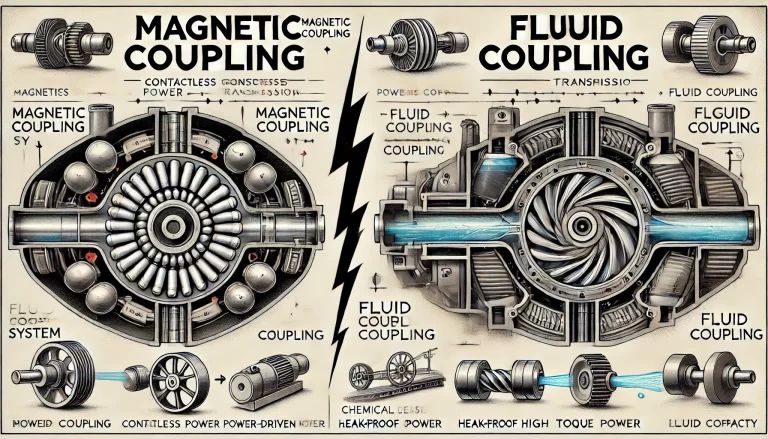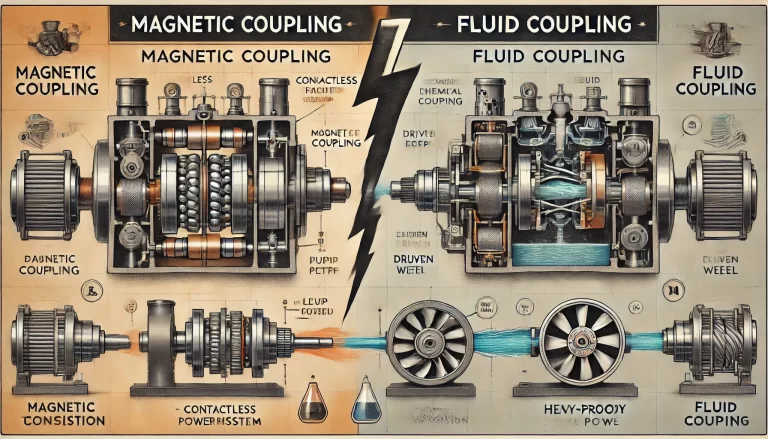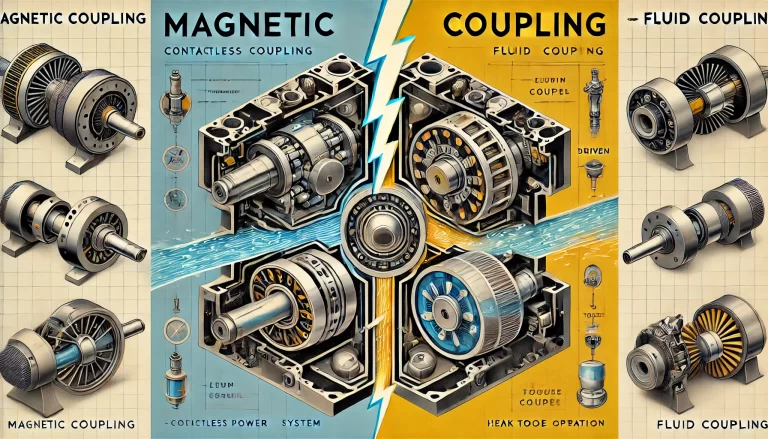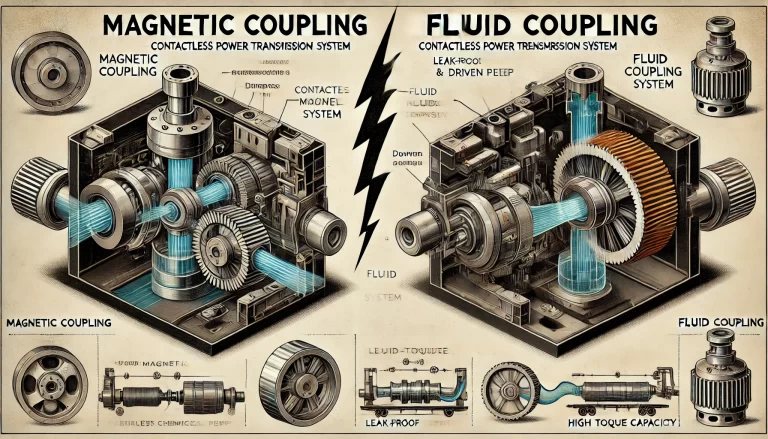Introduction
In modern mechanical engineering, magnetic coupling and fluid coupling are two crucial power transmission methods widely used in various industrial applications. Although both serve the primary function of transmitting power efficiently, they differ significantly in working principles, applicable environments, advantages, and limitations. This article provides an in-depth comparison of these two coupling technologies, offering insights into their suitability for different industrial machinery applications.

1. Magnetic Coupling
1.1 Working Principle
Magnetic couplings operate based on the principle of magnetic field transmission, primarily used in machinery requiring high-precision control and efficient power transmission. The core components of a magnetic coupling include two rotors:
Driving Rotor: Contains permanent magnets or electromagnets.
Driven Rotor: Made of ferromagnetic materials or conductive elements.
When an electric current passes through the electromagnet (in the case of an electromagnetic coupling), it generates a magnetic field that interacts with the other rotor across an air gap or non-contact medium, thereby transmitting torque. Since there is no physical contact between the two rotors, friction, wear, and mechanical overload issues are significantly reduced.
1.2 Advantages and Disadvantages
Advantages:
✅ Contactless Power Transmission: Magnetic couplings transfer power through magnetic fields, eliminating the need for direct mechanical contact. This results in lower wear and reduced maintenance costs. ✅ High Isolation: Effectively isolates the driving and driven components, preventing mechanical wear and electrical interference. This makes it ideal for applications in hazardous, explosive, flammable, or corrosive environments, such as chemical plants and pharmaceutical factories. ✅ High Precision and Stability: Due to their low vibration and minimal energy losses, magnetic couplings are perfect for high-precision applications, such as precision pumps, air compressors, and laboratory equipment.
Disadvantages:
❌ Limited Power Transmission: Due to the physical limitations of magnetic fields, magnetic couplings cannot handle very high power or high torque loads. ❌ Dependency on Stable Power Supply: Electromagnetic versions require a constant and stable power source, making them vulnerable to power fluctuations. ❌ Higher Initial Cost: The use of high-grade magnetic materials and the need for precise manufacturing increase the cost compared to conventional mechanical couplings.
1.3 Typical Applications
Magnetic couplings are widely used in industries where sealing, precision, and contamination prevention are essential. Common applications include:
Chemical and pharmaceutical industries (e.g., magnetic pumps preventing leakage of hazardous fluids)
Food processing equipment
Medical devices requiring sterilization and contamination-free operation
Industrial automation systems where precision and longevity are critical

2. Fluid Coupling
2.1 Working Principle
Fluid couplings operate on fluid dynamics principles, making them ideal for high-power applications that require smooth startup and torque control. A typical fluid coupling consists of:
Pump Wheel (Driving Side) – Accelerates the fluid
Turbine Wheel (Driven Side) – Receives energy from the moving fluid
Sealed Housing filled with transmission fluid
When the pump wheel rotates, the fluid inside is accelerated and directed toward the turbine wheel, which, in turn, is driven by the kinetic energy of the fluid. This mechanism allows power transmission without mechanical contact between the two wheels.
2.2 Advantages and Disadvantages
Advantages:
✅ Smooth Start and Adjustable Torque: Fluid couplings enable gradual power engagement, making them suitable for heavy-load applications that require controlled acceleration, such as conveyors and power transmission systems. ✅ No Mechanical Contact Wear: Since the power is transmitted through fluid flow, there is minimal mechanical wear, enhancing the lifespan of the machinery. ✅ High Load Capacity: Fluid couplings can handle high power and high torque loads, making them ideal for heavy-duty applications such as mining, metallurgy, and marine engines.
Disadvantages:
❌ Lower Efficiency: Due to fluid friction and energy dissipation, fluid couplings tend to have lower efficiency compared to direct mechanical or magnetic couplings. ❌ High Maintenance Requirements: Transmission fluid degrades over time due to temperature variations and contamination, requiring regular replacement and maintenance. ❌ Bulky Size: Fluid couplings are large and heavy, which may be a disadvantage in space-constrained applications.
2.3 Typical Applications
Fluid couplings are commonly used in high-power applications where smooth torque transmission and overload protection are critical, including:
Mining and heavy machinery (e.g., excavators, crushers, conveyor belts)
Power plants (e.g., turbine-driven generators, cooling fans)
Marine propulsion systems (e.g., ship engines)
Hydraulic systems requiring stable power transmission

3. Key Differences Between Magnetic and Fluid Couplings
| Feature | Magnetic Coupling | Fluid Coupling |
|---|---|---|
| Transmission Method | Magnetic field (non-contact) | Fluid flow (hydrodynamic) |
| Power Capacity | Limited to small/medium loads | Suitable for high-power applications |
| Efficiency | Higher efficiency due to reduced friction | Lower due to fluid resistance |
| Wear and Maintenance | Minimal wear, low maintenance | Requires periodic fluid replacement and maintenance |
| Application Scenarios | High-precision, leak-proof environments | Heavy-duty, high-torque applications |
| Cost | Higher due to precision manufacturing | Lower initial cost but higher maintenance cost |

4. Conclusion
Both magnetic couplings and fluid couplings offer unique benefits, and the choice between them depends on specific application requirements:
Magnetic couplings are ideal for applications demanding high precision, no physical contact, and protection against leakage and contamination, such as chemical, pharmaceutical, and high-tech industries.
Fluid couplings excel in high-power, high-torque, and heavy-duty applications where smooth startup, overload protection, and durability are essential, such as mining, metallurgy, power plants, and marine systems.
Understanding their working principles, advantages, and application scenarios helps engineers make informed decisions to optimize equipment performance, reliability, and lifespan. As industrial technology continues to advance, hybrid coupling solutions that combine magnetic and fluid technologies may emerge to further enhance efficiency and operational flexibility.
